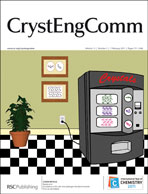Metal–organic frameworks based on transition-metal carboxylate clusters as secondary building units: synthesis, structures and properties†
Abstract
Five new metal–organic frameworks, [Zn2.5(SIP)(azopy)1.5(OH)2(H2O)]n (1), {[Zn1.5(SIP)(azopy)1.5(H2O)2]·0.5(azopy)·2H2O}n (2), {[Cd1.5(SIP)(azopy)1.5(H2O)2]·0.5(azopy)·2H2O}n (3), {[Cd2.25(SIP)0.5(μ3-OH)3(H2O)]·0.5H2O}n (4), and [Cu3(SIP)(CH3COO)(μ3-OH)2(μ2-H2O)(H2O)]n (5) were produced by hydrothermal reactions of NaH2SIP (NaH2SIP = 5-sulfoisophthalic acid monosodium salt) with azopy (azopy = ![[1 with combining macron]](https://www.rsc.org/images/entities/char_0031_0304.gif) space group and exhibits a 3D metal–organic framework with typical pcu topology. 2 and 3 are isomorphic and crystallize in the monoclinic space groupP2/c, both feature an interesting 3D coordination framework with an unprecedented {62.84}{63}2{64.82}2 topological structure, which has been deposited in the Reticular Chemistry Structure Resource (RSCR) named as zlm net. 4 crystallizes in the monoclinic C2/m space group and displays a 3D architecture with interesting coordination modes. 5 crystallizes in the triclinic space group P
space group and exhibits a 3D metal–organic framework with typical pcu topology. 2 and 3 are isomorphic and crystallize in the monoclinic space groupP2/c, both feature an interesting 3D coordination framework with an unprecedented {62.84}{63}2{64.82}2 topological structure, which has been deposited in the Reticular Chemistry Structure Resource (RSCR) named as zlm net. 4 crystallizes in the monoclinic C2/m space group and displays a 3D architecture with interesting coordination modes. 5 crystallizes in the triclinic space group P![[1 with combining macron]](https://www.rsc.org/images/entities/char_0031_0304.gif) and possesses a 2D coordination configuration with a hexanuclear Cu6O4(COO)6 cluster as the secondary building unit. The luminescence analysis on 1–3 and the magnetic analysis on 5 were performed and discussed.
and possesses a 2D coordination configuration with a hexanuclear Cu6O4(COO)6 cluster as the secondary building unit. The luminescence analysis on 1–3 and the magnetic analysis on 5 were performed and discussed.


 Please wait while we load your content...
Please wait while we load your content...